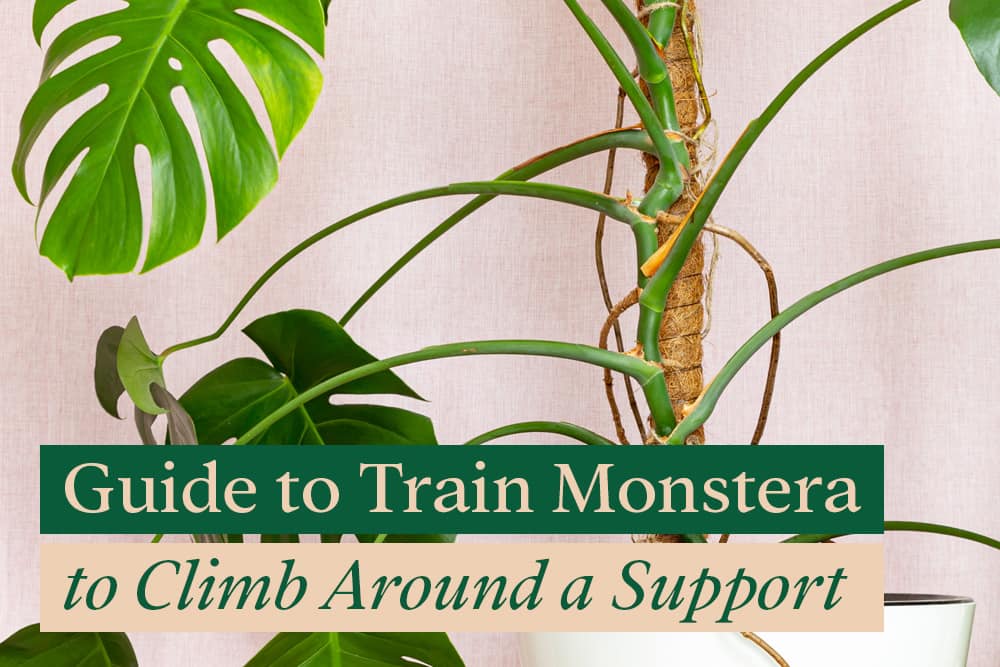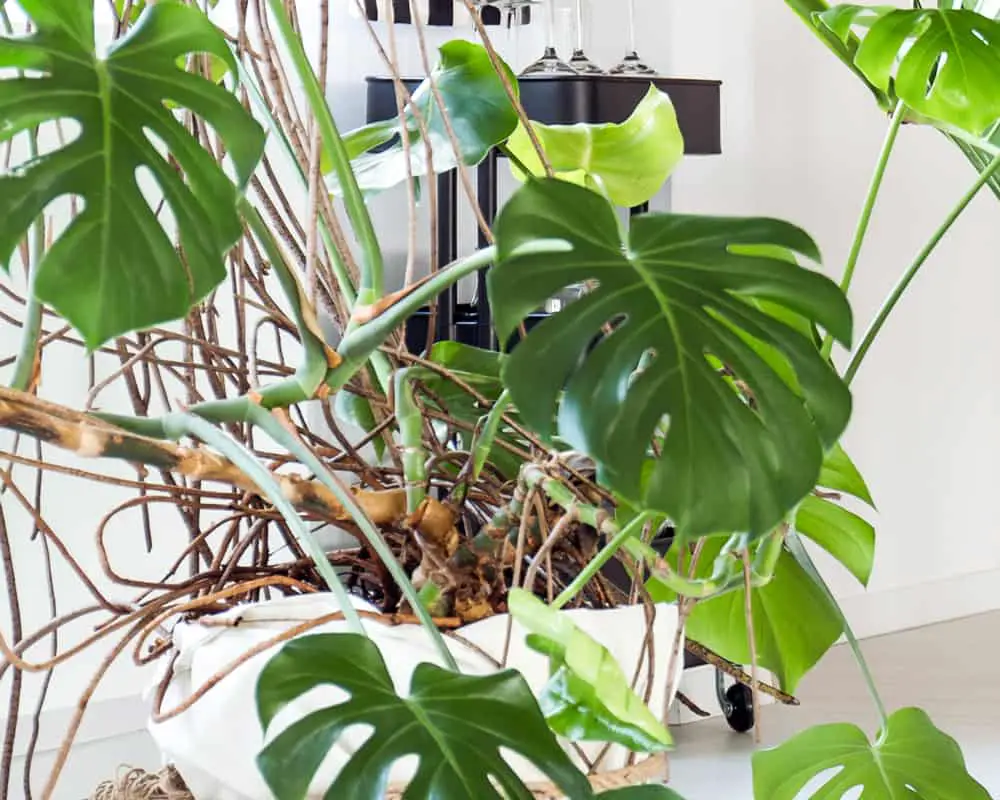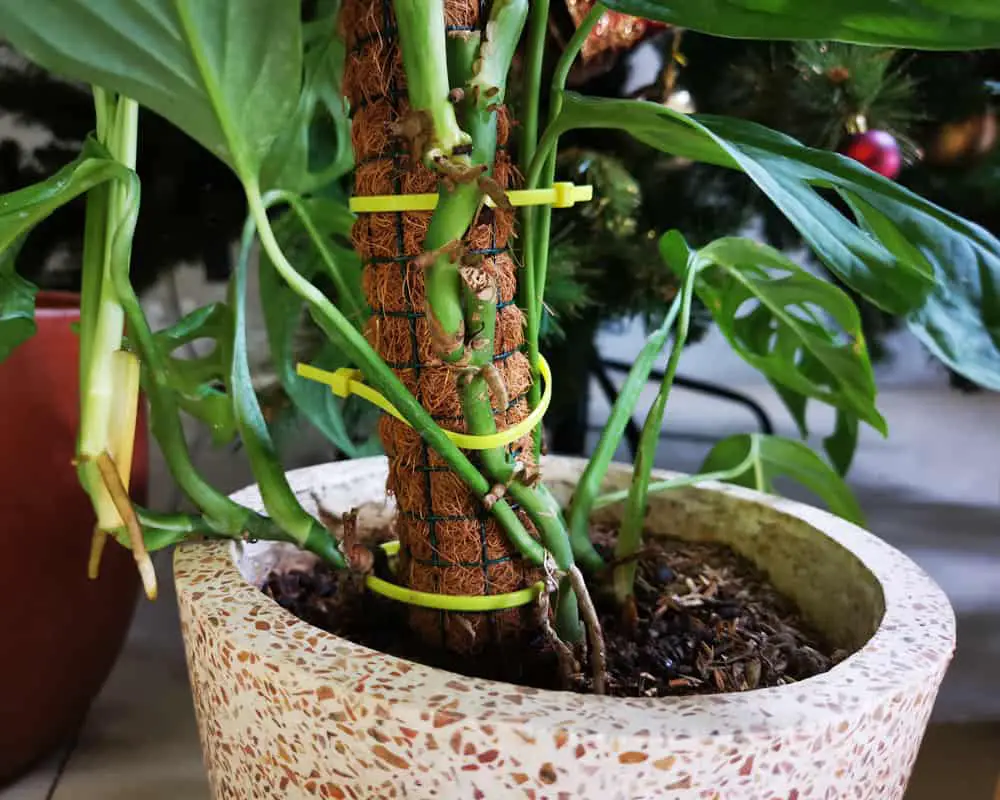
What do you do when your Monstera grows so tall it starts to fall over? It needs something to climb!
Monsteras are vining plant and climb up trees in their natural jungle habitat. We replicate this for potted Monsteras by using a moss pole or other vertical support. This allows your Monstera to grow up towards the light without falling over and damaging its stem, and it keeps the big plant from taking over your living room.
If you have never used a moss pole before, there are some important things you need to know to make sure you keep your Swiss Cheese plant happy.
This post will cover:
- Reasons to stake a Monstera
- How to make a moss pole support
- Training Monstera on a moss pole
- Additional Tips
- Concerns for allowing Monstera to climb
Let’s get started!
Disclaimer: As an Amazon Associate I earn from qualifying purchases.
Reasons to Stake a Monstera
There are three main reasons you may want to consider giving your Monstera houseplant vertical support:
- It replicates its natural habitat.
- Your Monstera will grow taller with bigger leaves with more fenestrations.
- It will help you avoid a messy-looking Monstera.
Replicate natural habitat
In their natural habitat of the tropical jungle, Monsteras climb up trees for support to reach better sunlight. They do this using their aerial roots, whose function is for support rather than absorbing nutrients like normal roots.
A moss pole or stake acts like a tree and supports the Monstera as if it was in the jungle. It holds onto extra moisture, which attracts the Monstera’s air roots, mimicking natural humidity and rainfall.
Grow bigger leaves and encourage fenestrations
When a Monstera grows up a tree or moss pole, its aerial roots wrap around it and absorb extra water and micronutrients. This gives the plant an extra boost. Especially in the wild, where Monsteras can grow very tall, this extra water source makes it easier to hydrate the upper leaves so they can grow nice and big.
The extra physical support encourages Monstera to grow bigger because its energy is no longer focused on supporting the stem. It can grow big, heavy fenestrated leaves now that it won’t flop over.
Avoid messy look

Without a moss pole or other vertical support, your Monstera will not be able to grow upright once it gets bigger. It will start sending out aerial roots for support, and it will start to grow off to the side.
Monsteras are an example of negative phototropism. This means that if they do not get enough light, they will start to grow away from the light source. This is their way of looking for a tree to climb up to reach more light.
If your Monstera does not have the support and wants more light, it may start to grow away from the window into your room!
Attaching to a moss pole will make your Monstera look more organized and intentional, and it will be easier to care for.
How to Make a Moss Pole Support
It is easy to make a moss pole for your Monstera!
You will need a few supplies and a place to assemble the moss pole that is okay to get wet.
What you need
- A pole about 2 feet (60 cm) taller than your Monstera. This can be a wooden dowel, bamboo, or a PVC pipe.
- Sphagnum moss
- String, twine, or wire
- A bucket or large bowl filled with water
Steps to Build a Moss Pole
Step 1: Soak the moss.
Place the sphagnum moss in the bucket of water and let it sit for 15 to 20 minutes. You can let it soak while you gather the rest of your materials.
You could use coconut coir instead of sphagnum moss, but it doesn’t hold onto moisture as well and would need misting more often.
Step 2: Attach your string to the top of the pole.
Tie a secure knot and wrap it around a couple of times for good measure.
Step 3: Wrap the Moss on to the Pole
Put the moss on the pole and wrap the string around it to attach it.
You want to try to keep the moss even, no more than 2 inches (5 cm) thick.
Keep wrapping the moss and string around the pole until you are a little ways away from the bottom. Leave the last foot or so (approximately 30 cm) bare. The bottom of the pole will be sticking down into the pot, and it is easier to work with when there is no moss on that part.
Tie off your string or wire, and you’re done!
Alternatively, Purchase Online
If this seems like too much work, there are still plenty of options online. Just make sure to pay attention to the length of the pole you are buying, so it is not too short for your Monstera.
Different material of Moss Pole
Moss is the most popular material for a Monstera’s support pole, but it is by no means the only one. Here are some other popular materials:
- Coconut coir works similar to moss, although it dries out a little faster.
- Bamboo stakes will provide vertical support but will not support aerial roots.
- Trellises will also provide sturdy support to your Monstera and are less likely to tip over.
Training Monstera on a Moss Pole
Your Monstera will need some assistance to climb up the moss pole! Here’s how you can help.
When to Add a Moss Pole?
The best time to add a moss pole to your Monstera’s pot is when it is young. This way, it hasn’t grown a sturdy stem in a wonky direction that’s hard to bend up onto the pole.
A young Monstera’s aerial roots will also still be very short and can be trained directly into the moss instead of growing long, reaching out towards the floor or wall.
Another thing to consider about the timing of installing a moss pole is if your Monstera is already in a pot or if you are repotting. It is better to add a moss pole at the same time that you are repotting. This way, it is less likely to disturb the roots and get deep enough to be very stable in the soil.
Consideration when Installing a Moss Pole
Here are a few things to keep in mind when installing a moss pole for your Monstera. You want to avoid disturbing its roots and maximize pole stability. You also want to think about the height of the pole and the material it is made of.
Avoid disturbing roots
It is best to add a new pole when you are in the process of repotting your Monstera. During this time, the soil is loose, and your Monstera has some wiggle room to make space for the pole.
If your Monstera is happy in its pot, you can still insert a moss pole. You just have to be careful. Gently dig out a space close to the center of the pot and stick the pole as far down as you can. It’s better to remove some soil so you can see where the roots are and not smash them.
Ways to Maximise Pole Stability
Your Monstera’s new moss pole is supposed to be sturdy support, so you need to make sure that it is stable in the pot!
When placing the moss pole, try to put it in the center of the pot. If it is too far to one side of the pot, it is more likely to fall out of balance, and the Monstera could fall over.
Make sure the soil is not loose around the pole. Pack the soil in after placing the pole and again after watering. Sometimes the water can cause the soil to settle in weird ways, and we don’t want that to affect your Monstera’s stability.
If you are still concerned about stability, you can brace the pole against the side of the pot using a chopstick or dowel. This will keep it from wiggling too much.
Size of the Moss Pole
Your Monstera’s moss pole should start a couple of feet taller than your Monstera. This way, it has some room to grow and climb.
A moss pole that is too short will provide some support at first, but you will eventually run into the same issues as before. Monstera will start growing off to the side, and there will be no place for its aerial roots.
The height of the moss pole is really only limited by the ceiling of your home or office. However, it does not make sense to buy a 6 foot (2 meters) tall pole when your Monstera is still a baby.
There are extendable moss pole options for your Monstera, which we will discuss further down in the article.
How to secure Monstera to Moss Pole
Once your moss pole is in the pot with your Monstera, you need to attach the plant to the pole!
If your plant is still young, this will be a little easier. Without tugging or bending too hard, tie the Monstera’s stem to the pole, so the nodes are touching the damp moss. This will encourage the aerial roots to grow into and around the moss pole.
You may need to repeat this process with any new growth. Once the Monstera’s aerial roots are firmly attached to the moss pole, you can remove or loosen the ties.
If your Monstera is already fairly mature, it may not want to bend so much to attach to the moss pole. You will have to do this very slowly. Use ties to start pulling the stem toward the moss pole, and tighten them every week until the stem is against the pole.
It may also be good for you to cut back some of the Monstera’s aerial roots if they are very long. The longer they are, the harder it will be to train them onto a support. If you cut the aerial roots close to the node, it will encourage more root growth, which will now grow into the moss pole.
Mist the Moss regularly.
Monstera’s air roots will be naturally attracted to the moss pole, but only if it is damp. It would help if you misted your moss pole regularly so that your Monstera can absorb extra moisture for its big, beautiful leaves.
Use VELCRO garden tie.
A great option for attaching your Monstera to the moss pole is to use VELCRO garden ties. These plant ties stick to themselves, so there is no need to worry about tying a knot that will be strong enough. They are easy to attach and remove, and they will not damage the stem of your Monstera.

Alternatively, you can use cable tie (zip tie) to tie the stems to the moss pole. At least until the aerial roots start to hug the support. This is what i did on my Monstera Adansonii.
Extending a Moss Pole
Some moss and coir poles on the market have the ability to stack to create a longer pole when your Monstera grows taller.
The most popular ones have space in the top big enough to hold another moss pole’s bottom stake. All you have to do is stack it right on top!
If you are worried about stability, you can wrap a thin stake around the moss poles where they overlap, just to give a little extra structure.
Other Alternatives to Moss Pole
If you don’t like a moss pole’s look, you can use other alternative supports for your Monstera.
A tall wooden or bamboo pole will support your Monstera as it grows tall.
A wider trellis can be useful support for your Monstera if it likes to grow very wide. This could look like a ladder or perhaps a tomato cage.
Additional Tips to Encourage Monstera Growth to Climb a Support
Some additional things you can do to encourage your Monstera to climb its moss pole include pruning and rotating the plant.
Pruning
As mentioned previously, pruning back your Monstera’s aerial roots will encourage new ones to grow in their place. This is useful so you can train new roots to cling to the moss pole.
You can also prune back parts of the main plant that are growing away from the pole rather than forcing them to bend in a way they don’t want to.
Plus, if you do this, you can propagate them to make a new baby Monstera or stick it back in the soil to give your plant a fuller look.
Rotating to Avoid Uneven Growth Pattern
When left in one place for a long time, your Monstera will turn its leaves toward the light source. This can cause the plant to become unbalanced.
Rotating the plant regularly—like every time you water it—will prevent the Monstera from growing too far in one direction away from the moss pole.
Concerns for Allowing Monstera to Climb
There are some downsides to consider about letting your Monstera climb up support. Introducing support like a moss pole for your Monstera will allow your plant to grow bigger than it would otherwise, and you will need to be able to manage those consequences.
Need to Trim Consistently Once Big
A trellis will make your Monstera happy, which means it will grow bigger and faster. To keep it from taking over your home, you will need to prune it more often. This is a good opportunity to propagate the cuttings and give away the babies to friends, family, and neighbors.
Difficult to Move Around
Not only will the damp moss pole add height and weight to the plant, but its new growth will also cause your Monstera to be bigger and heavier. This will make your Monstera much harder to move around. You will need to have a designated corner or window for your Monstera or at least a friend to help you move it every once in a while.
May Need More Watering and Fertilizing
Faster growth means your Monstera will want more water and fertilizer! Pay attention to your Monstera’s growth habits and soil moisture. Water when the soil starts to dry out. Fertilize when your Monstera is actively growing.
